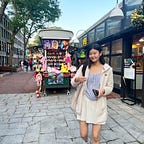Existentialism in Howl’s Moving Castle
White noise interrupted by a low rumbling in the distance as a mechanical entity strides into view. A low, close-up shot of its metal-plated chicken legs; a tilt, three-quarter shot of its frontal: two round protuberances set off by a serrated ridge. In multi-toned wheezes, the creature spews charcoal-black, then bone-white exhaust into a thick fog that cloaks the landscape. What Miyazaki presents in the opening scene of “Howl’s Moving Castle” — via this lumbering animal dressed in industrial — is a portrait of the post-modern individual struggling to find his or her place in a world shrouded in moral ambiguity.
It’s no secret that world-renowned director and writer Hayao Miyazaki tends to keep to a particular story template: the young heroine’s coming-of-age. Just look at the wealth of Miyazaki animations that sport this basic plot: “My Neighbor Totoro” (1988), “Kiki’s Delivery Service” (1989), “Princess Mononoke” (1997), and “Spirited Away”(2001), just to name a few. While “Howl’s Moving Castle” (2004) also features a young heroine in the character Sophie at its outset, it does not stay entirely true to type, as — not even fifteen minutes in — the adolescent Sophie is turned into a hunchbacked, elderly woman, and remains so for the remainder of the film. “Howl’s Moving Castle” — in its centering on a character well-past the threshold of physical maturation — is a certain outlier within Miyazaki’s award-winning anthology.
Indeed, “Howl’s Moving Castle”, while a seemingly light-hearted film, is in actuality a profound existential reckoning: a representation of both mankind’s pursuit of self, and how that pursuit is encroached upon and hindered by the shapeless evil and meaningless suffering of the world. Throughout most of “Howl’s Moving Castle”, the external world represents a pervasive threat to the characters and their passage to self-discovery. Indeed, the film sketches the outside world as such as early on as Sophie’s first scene, wherein the smoke of a passing train literally colors the view outsider her window ashen. As the film progresses, the external danger that is implied in darkened skies, becomes explicit, taking on both fantastical and real-world forms.
While the external evils presented over the course of the film vary in configuration, all share the same formless and inexplicable nature. In this regard, the blob-men — gelatinous beings that unexpectedly emerge from building walls and doorframes — are the most literal depictions of worldly peril, or at least that according to the film. Upon withdrawing from the safety of her hat shop, the first type of external danger Sophie encounters comes in the mold of everyday men. Similar to the blob-men, whose lack of identifiable features render them indistinguishable from each other, the pair of wolfish guards that “mouse call” Sophie —their identities obscured by military garb— remain de-individualized and anonymous. The guards harassment, recalling the way the blob-men seem to spring physically out of nowhere, is as startling as it is unjustified.
“Howl’s Moving Castle” also shows the male presence difficult, if not impossible, for young women to free themselves of, as the bakery that Sophie escapes to is dominated by yet more men. The majority of Lettie’s scenes — both those she occupies alone and with Sophie — are in fact interrupted by the greetings or bids of men: “Any chocolate letties?”; “Look this way, Lettie.”; “Let’s go for a walk, Lettie.”; “Come back soon, Lettie.”; “Lettie, why not use the office?”; “Lettie, the Madelines are done.”; “Hello, Lettie. Bye, Lettie.” Though delivered in pleasant tones, these remarks — some more sexually suggestive than others — are come-ons onto Lettie and threats of intrusion into her space. The men’s frequent and deliberate tagging of Lettie’s name in their utterances also serve the purpose of underscoring their comparative anonymity, which parallels that of the uniformed guards and the faceless blob-men. Worldly danger, as it manifests itself in men, is therefore non-specific and pervasive.
Another representation of external peril that Miyazaki offers in his film is war. A primary driver of the film’s plot as well as the backdrop against which that plot unfolds, war — the weight of whose presence crescendos as the film progresses — differs from predatory and obtrusive men in that it also claims victim to male characters, and magically-endowed ones at that. Much broader in its scope of victimization, Miyazaki’s war, however, also shares important characteristics with his imagined blob and real-world men. Depicted in oodles of vibrantly colored flags, post-apocalyptic landscapes of fire, and sweeping propagandistic pieces — posters displaying hackneyed, symbolic images of war and flyers whose only readable text is the world “war” in all capital letters — , war is loud, yet haphazardly cast about (textually, verbally, and illustratively) in the world of “Howl’s Moving Castle”. The audience, in other words, is neither informed of which parties the war is in between, nor their respective reasons for conflicting with one another. War thus comes to embody a dispassionate confusion, a slipshod “burn[ing] [of] cities and people” that is as meaningless and inexplicable as the danger posed by the blob and over-stepping men.
True, “Howl’s Moving Castle” diverges from Miyazaki’s others in its portrayal of an older heroine: but does this heroine, in the face of such external threats, not undergo a development similar to those undertaken by Miyazaki’s animated starlets? We must refrain from discounting — on the mere basis of Sophie’s age — the very concept which Miyazaki sought to, by designating an old woman the main character, illustrate and engage with in the film: metaphysical maturation. As well-crafted as the characters and plot of “Howl’s Moving Castle” are, the film’s exploration of the individual’s battle against worldly peril is what I would argue explains its dynamistic popularity among viewers of all ages, around the world.
